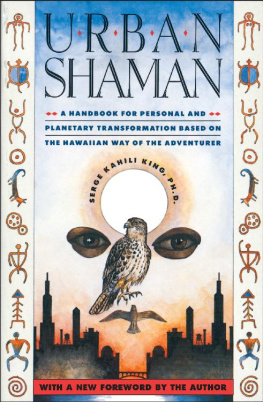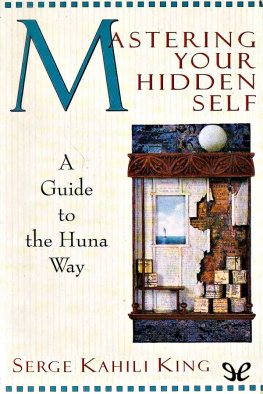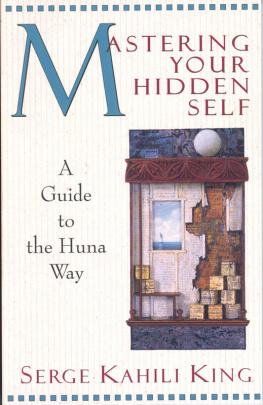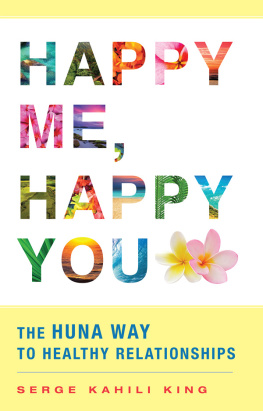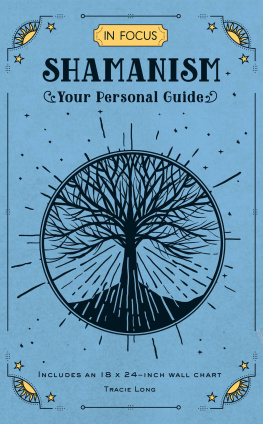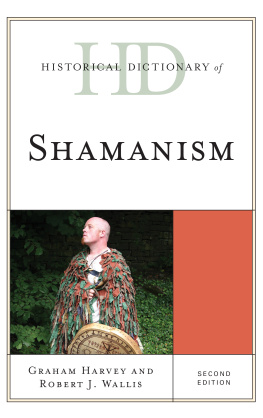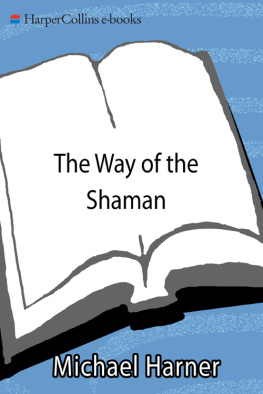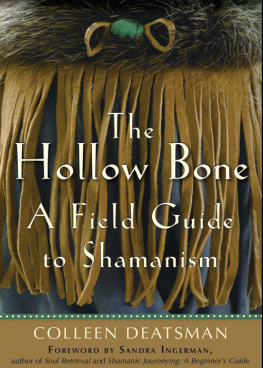Also by Serge Kahili King, Ph.D.
Imagineering for Health
Kahuna Healing
Mastering Your Hidden Self
The Pyramid Energy Handbook
Serge Kahili King has a doctorate in psychology from California Western University. He has studied with master shamans from Africa to Hawaii and has trained thousands in his popular seminars. He lives in Princeville, Hawaii.

A Fireside Book
Published by Simon & Schuster
New York
authors.simonandschuster.com/Serge-Kahili-King
THE FIRST ADVENTURE: THE EVOLUTION OF HAWAIIAN SHAMANISM
Waiho wale kahiko (Old secrets are now revealed)

T hunder crashed, the wind roared, torrents of rain filled the air, and mountainous waves rose and fell, yet still the mighty Maui pulled and heaved on his magic fishhook. Finally, with the sound of a thousand waterfalls the islands of Hawaii rose slowly from the sea. Maui had triumphed once again and mankind had new land to explore and cultivate.
The evolution of Hawaiian shamanism begins with the myths of Maui. Magician, trickster, demigod, miracle worker, luck bringerMaui was known as all these things from one end of Polynesia to the other, the only male figure of Polynesian myth to be so renowned. The only female mythological being in Polynesia with as widespread a reputation was Hina, goddess of the moon and mother of Maui.
The stories told of Maui as abundantly recorded in Beckwiths Hawaiian Mythology, Andersens Myths and Legends of the Polynesians, and Fornanders An Account of the Polynesian Race make it clear that he was an archetypal shaman in the same ancient tradition found elsewhere in the world, with a Polynesian touch. Besides pulling up the islands of Hawaii (a discovery myth), he slowed down the sun so his mother could dry her clothes (another discovery myth of finding lands in high northern latitudes), visited the Upper World and tricked the gods into giving up the secret of fire (a myth of creative intuition through shamanic trance), visited the Underworld to overcome various monsters (another myth of shamanic trance for healing), was able to use magic and magical items, and spoke freely with birds, animals, and the natural elements. Maui was the most popular figure in Polynesian myth because of his helpfulness, his adventurousness, his irreverence for authority, and his accessibility. As a demigod (more properly, a human with magical abilities), he was never worshiped, but he could be called on for luck. In New Zealand, where the Maori carved his likeness in wood or jade in the form of a human embryo and often wore it as a charm, he was called Maui Tikitiki; in Hawaii, where no likeness of him was ever made, he was called Maui Kupua. Both names can be translated as Maui the Shaman.
The Kahuna Orders
Very early in Polynesia (some traditions, such as those of the Kahili familywhich adopted meand those recorded by Leinani Melville in Children of the Rainbow, are said to go back as far as the lost continent of Mu, although in fairness there are many who disagree with that) there came into being a philosophy of life called Huna the secret or the hidden knowledge. The name did not refer to any desire to keep the knowledge away from others, but rather it referred to a knowledge of the hidden or unseen side of things. The expert or master practitioners of this philosophy were called kahuna in Hawaiian, tahuna in Tahitian, and tohunga in Maori. At some point these experts formed themselves into three loosely formed separate groups. The existence of these three groups is noted by many sources (e.g., Malos Hawaiian Antiquities and The Kamehameha Schools Ancient Hawaiian Civilization), but most of the specifics that follow were given to me by Ohialaka Kahili and Wana Kahili, my aunt and uncle by Hawaiian-style adoption. When I was seventeen I was hanaid (adopted) by the Kahili family, after my natural father had died. This is not a legal form of adoption, but for the Hawaiians it means being taken into their family as one of their own.
One of the groups mentioned above focused on the arts of physical therapy, ceremonial religion, politics, and war. In Hawaii it was known as the Order of Ku. A second group focused on the spiritual and material aspects of crafts and sciences such as fishing and farming, shipbuilding and navigation, wood carving and herbalism. This was the Order of Lono in Hawaii. The third group, the Hawaiian Order of Kane, focused on magic, mysticism, and psychology, and these were the shamans. Each order had many subcategories, and while there were healers in each one, the art of healing through spirit became the primary activity of the shamans. Ku, Lono, and Kane (pronounced kah-nay) were archetypes or personifications of Body, Mind, and Spirit. The full name of Kane was originally Kanewahine, which may be translated as manwoman, and refers to an understanding of polarities similar to the yin/yang concept of Taoist shamans. Kane was an archetypal god of forests, high places, water sources, and peace. This is significant because the Hawaiians as a rule only inhabited the shorelines of their islands. Apart from special forays for sandalwood, tall trees for oceangoing canoes, and feathers for capes, the only Hawaiians who spent much time in the forests and uplands were the shamans.
As a guild, the Order of Kane was roughly divided into apprentices, journeymen, and masters, though different teachers might change the number of categories. When I was being trained I started out as an apprentice and then mastered different areas as I progressed. Hawaiian shamans, like shamans everywhere, have no hierarchy among themselves. The apprentices are students and colleagues, not followers, and the master is a master of knowledge, not of people. The Hawaiian word for master in the sense of someone with spiritual and material expertise in a given area is kahuna, as mentioned above. That word is used very loosely nowadays, but in proper usage, and to have any real meaning, it should always have a qualifier added. For instance, a master healer who uses herbs, massage, and energy work is a kahuna lapaau; a master of prayer and ceremony is a kahuna pule; and a master shaman is a kahuna kupua. As an aside, the big kahuna of the surfing beaches would be a kahuna hee nalu. And the black magician or sorcerer was called a kahuna anaana.
A great deal of nonsense has been written and presented about the kahunas of Hawaii, ranging from the red flash in the eye one is supposed to see on meeting a real kahuna, to their healing broken bones instantly without fail, to raising the dead, and to the infamous death prayer. Since much of the credit or blame for these things is laid on the shamans, I would like to clarify these issues here and now.
To begin with, the belief in the red flash (which has even appeared on television) came about because of a play on words, so greatly enjoyed by Polynesians. The word used for flash is makole, which means red eyed and refers even to conjunctivitis. But the same word also means rainbow and that is a symbol for the presence of chiefs, gods, or spirits. As applied to a kahuna, it is a word of respect.
The instant healing of a broken bone is possible for any healer under the right conditions. Specifically, it can occur when there is abundant energy and faith, and no doubt. The kahunas reputation for this skill is mostly due to a single story in a book by Max Freedom Long entitled The Secret Science Behind Miracles. In the book he tells of a female kahuna who instantly healed the leg of a man who broke it while he was drunk. Obviously, the kahuna had the energy and the faith, and the man was probably too drunk to have any doubt. Not even kahunas can do it every time without fail, however.
Next page
